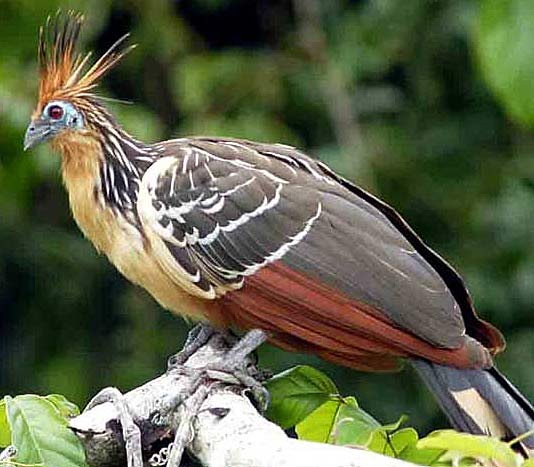Post by Ceratodromeus on Feb 7, 2017 22:46:30 GMT 5

Scientific classification
Kingdom: Animalia
Phylum: Chordata
Subphylum: Vertebrata
Class: Aves
Order: Opisthocomiformes
Family: Opisthocomiformidae
Genus: Opisthocomus
Species: O.hoatzin
Taxonomy
The Hoatzin was originally described by German zoologist Statius Müller in 1776. It is arguably the most enigmatic living bird in regard to its phylogenetic relationships. No satisfying evolutionary hypothesis has been proposed, and the situation has become worse with the availability of DNA sequence data.
There has been much debate about the Hoatzin's relationships with other birds. Because of its distinctness it has been given its own family, the Opisthocomidae, and its own suborder, the Opisthocomi. At various times, it has been allied with such taxa as the tinamous, the Galliformes (gamebirds), the rails, the bustards, seriemas, sandgrouse, doves, turacos and other Cuculiformes, and mousebirds. Altogether, it has been most frequently suggested to be related to Galliformes, turacos, or the anis (New World cuckoos).
Biology
The Hoatzin (Opisthocomus hoazin), also known as the Hoactzin, Stinkbird, or Canje Pheasant, is a species of tropical bird found in swamps, riverine forest and mangrove of the Amazon and the Orinoco delta in South America.
_world.png/220px-Hoatzin_(Opisthocornus_hoazin)_world.png)
It is notable for having chicks that possess claws on two of their wing digits.
It is the only member of the genus Opisthocomus (Ancient Greek: "wearing long hair behind", referring to its large crest[clarification needed]), which in turn is the only extant genus in the family Opisthocomidae. The taxonomic position of this family has been greatly debated, and is still far from clear.
The Hoatzin is pheasant-sized, with a total length of 65 centimeters (26 in), with a long neck and small head. It has an unfeathered blue face with maroon eyes, and its head is topped by a spiky, rufous crest. The long, sooty-brown tail is broadly tipped buff. The upperparts are dark, sooty-brown-edged buff on the wing coverts, and streaked buff on the mantle and nape. The underparts are buff, while the crissum, primaries, underwing coverts and flanks are rich rufous-chestnut, but this is mainly visible when it opens its wings. The alternative name of "stinkbird" is derived from the bird's manure-like odor, caused by its digestive system. The Hoatzin is herbivorous, eating leaves and fruit, and has an unusual digestive system with an enlarged crop used for fermentation of vegetable matter, in a manner broadly analogous to the digestive system of mammalian ruminants. The name Stinkbird is related to a strong smell produced by this bird, perhaps due to the fermentation of leaves.

This is a noisy species, with a variety of hoarse calls, including groans, croaks, hisses and grunts. These calls are often associated with body movements, such as wing spreading. Calls are used to maintain contact between individuals in groups, warn off threats and intruders and by chicks begging for food.
The Hoatzin eats the leaves and to a lesser degree fruits and flowers of the plants which grow in the marshy and riverine habitats where it lives. It clambers around clumsily among the branches, and being quite tame (though they become stressed by frequent visits), often allows close approach and is reluctant to flush. The Hoatzin uses a leathery bump on the bottom of its crop to help balance itself on the branches. It was once thought that the species could only eat the leaves of arums and mangroves, but the species is now known to consume the leaves of over fifty species. One study undertaken in Venezuela found that the Hoatzins diet was 82% leaves, 10% flowers and 8% fruit.
One of this species' many peculiarities is that it has a digestive system unique amongst birds. Hoatzins use bacterial fermentation in the front part of the gut to break down the vegetable material they consume, much like cattle and other ruminants. Unlike ruminants, however, which possess the rumen (a specialized stomach for bacterial fermentation) in the Hoatzin this is the function of the crop (an enlargement of the esophagus). The crop of the Hoatzin is so large as to displace the flight muscles and keel of the sternum, much to the detriment of their flight capacity. Because of aromatic compounds in the leaves they consume and the bacterial fermentation, the bird has a disagreeable, manure-like odor and is only hunted by humans for food in times of dire need. Any feeding of insects or other animal matter is purely accidental.
Hoatzins are seasonal breeders, breeding during the rainy season, the exact timing of which varies across its range. Hoatzins are gregarious and nest in small colonies, laying two or three eggs in a stick nest in a tree hanging over water in seasonally flooded forests. The chicks, which are fed on regurgitated fermented food, have another odd feature; they have two claws on each wing. Immediately upon hatching, they are able to use these claws, as well as their oversized feet, to scramble around the tree branches without falling into the water. When predators such as the Great Black Hawk attack a hoatzin nesting colony, the adults fly noisily about, trying to divert the predator's attention, while the chicks move away from the nest and hide among the thickets. If discovered, however, they have another amazing trick: they drop into the water and swim under the surface to escape, then later use their clawed wings to climb back to the safety of the nest.

Original author
animaliaenthusiasts.proboards.com/user/3




